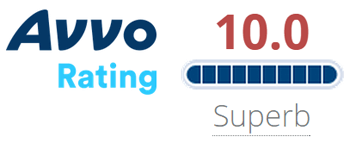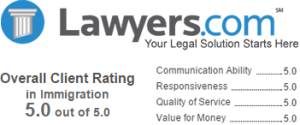[Federal Register: April 16, 2001 (Volume 66, Number 73)] [Rules and Regulations] [Page 19390-19394] From the Federal Register Online via GPO Access [wais.access.gpo.gov] [DOCID:fr16ap01-6] ======================================================================= ----------------------------------------------------------------------- DEPARTMENT OF STATE 22 CFR Part 41 [Public Notice 3644] Visas: Nonimmigrant Classes; Legal Immigration Family Equity Act Nonimmigrants, V and K Classification AGENCY: Bureau of Consular Affairs, Department of State. ACTION: Interim rule with request for comments. -----------------------------------------------------------------------Client Reviews

Legal Guru in All Things Immigration
“Mr. Shusterman and his law firm have represented my family and me very successfully. He is not only a legal guru in all things immigration but even more so he is an exceptional human being because he empathizes with his clients and cares that justice is done.”
- Maria Davari Knapp, Chicago, Illinois
Read More ReviewsSUMMARY: This rule implements five new nonimmigrant visa categories (V1, V2 and V3 and K3, K4) established pursuant to the Legal Immigration Family Equity (LIFE) Act that was enacted on December 21, 2000. The new categories permit United States consular officers to issue nonimmigrant visas to the spouse, child and, in some instances, the child of the child of a lawful permanent resident alien (LPR) and to the spouse of a United States citizen and the child(ren) of the spouse. Issuance of nonimmigrant visas will permit these aliens to apply for admission into the United States as nonimmigrants where they may await the completion of the immigration process with their U.S. citizen or LPR family member. DATES: This interim rule is effective April 1, 2001. Written comments must be received no later than June 1, 2001. ADDRESSES: Written comments may be submitted, in duplicate, to H. Edward Odom, Chief, Legislation and Regulations Division, Visa Office, Room L603-C, SA-1, Department of State, Washington, DC 20520-0106. FOR FURTHER INFORMATION CONTACT: H. Edward Odom, Chief, Legislation and Regulations Division, Visa Office, Room L603-C, SA-1, Department of State, Washington, D.C. 20520-0106, (202) 663-1204; or e-mail:odomhe@state.gov. SUPPLEMENTARY INFORMATION: Background What is the Purpose of the New Visa Categories and Who Benefits From Them? On December 21, 2000 the President signed into law the Legal Immigration Family Equity (LIFE) Act, Title XI of H.R. 4942, Pub. L. 106-553. Sections 1102 and 1103 of the LIFE Act add to the existing nonimmigrant categories of section 101(a)(15) of the Immigration and Nationality Act (INA), 8 U.S.C. 1101(a)(15), two new categories, one subdivided into three subcategories (V1, V2, V3) and the other into two subcategories, (K3, K4). The underlying purpose of this legislation is to reunite families that have been or could be subject to a long period of separation during the process of immigrating to the United States. Therefore, once admitted as a V or K nonimmigrant, the alien generally will be permitted to remain in the United States with his or her family until the visa petition is approved or denied. Then, if the petition is approved, the alien may continue to remain until the application for adjustment of status is approved or denied, or may depart to seek the issuance of an immigrant visa at the appropriate consular office abroad. In both the new V and K categories the spouses and children affected are those for whom an immigrant visa or adjustment of status are not available despite the petition having been filed. The lack of availability of a visa or opportunity to adjust status in many cases may be due to lengthy processing delays. In the cases of many spouses and children of lawful permanent residents (LPRs) it may be due to the fact that no visa number has yet become available to the alien because of the annual numerical limitation placed on immigrant visas in the second preference category. The new category ``V'' is intended for use by certain spouses and unmarried children of LPRs who have filed second preference petitions in their behalf pursuant to INA 203(a)(2)(A), and by the unmarried children of those principal beneficiaries. A spouse who qualifies for V status will be classified as V1. A petitioned-for child will be classified as V2. A derivative child of either will be classified as V3. Under the LIFE Act, no benefits accrue in the new categories until three or more years after the date on which a second preference petition was filed on behalf of the principal beneficiary. The LIFE Act also adds new subcategory K(ii) to the existing K (fianc(e)) nonimmigrant category. The original K category has been renumbered K(i) and modified to remove derivative children and place them in a new K(iii) subcategory along with the children of an alien classified under the new K(ii) subcategory. Nevertheless, a fiance(e) of a U.S. citizen will continue to be designated K1 for visa purposes. A derivative child of a K1 alien will still be designated K2. The new K3 visa is intended for use by a spouse of a United States citizen for whom a spousal immediate relative petition has been filed in the United States. The spouse's child(ren) will be designated K4. Unlike the new V3 category, neither existing legislation nor the LIFE Act provides for visa issuance to the child of a child of the spouse or the petitioner. V Visas What are the Requirements to Obtain Classification as a V1, V2, or V3 Nonimmigrant? In order to obtain classification as a nonimmigrant under V1 or V2 the alien applicant must first establish that a second preference (F2A) petition (I-130) as the spouse or child of an LPR had been filed in his or her name on or before the date the LIFE Act was enacted, i.e., December 21, 2000. Further, the applicant must establish that either: (1) The petition in the applicant's name has not been acted upon after three years or more, or (2) if the petition has been approved, three years or more have passed since the petition was filed and either no visa number has become available because of the worldwide or per country numerical limitation, or even though a number is available the alien's application for [[Page 19391]] adjustment of status or visa application remains pending. In order to obtain nonimmigrant classification under V3, the applicant must establish that he or she is the child of a principal alien entitled to classification under V1 or V2. All applicants must demonstrate that they are otherwise eligible for visa issuance under all other applicable immigration laws, including those pertaining to the exclusion of aliens other than INA 212(a)(6)(A), 212(a)(7) and 212(a)(9)(B) from which they are specifically exempted by the LIFE Act. When is an Immigrant Visa Application Considered to Remain Pending for the Purpose of Obtaining a V Visa? As stated, if a visa number is available to the alien, in order for the alien to obtain a V visa the alien's immigrant visa application must ``remain(s) pending''. However, the LIFE Act does not give any indication as to what is meant by the phrase ``application for a visa remains pending''. It could refer to the time period between the date on which the alien's visa number becomes available and the date the alien is given an appointment at an embassy or consulate in order to apply for an immigrant visa. Or, it could refer to the time period between the alien's actual application for a visa and the date on which a decision is made on the application. Considerable delay at either stage can cause hardship. In view of the specific wording of the LIFE Act, however, Congress appears to have contemplated that the alien must first actually apply for an immigrant visa before he or she may be considered eligible for a V visa. The application must then remain pending. The Department will thus interpret the phrase ``application for a visa remains pending'' to mean that the alien has applied for an immigrant visa pursuant to current regulations, i.e., has personally appeared before a consular officer and verified by oath or affirmation the statements contained on the Form OF-230 and in all supporting documents, has previously submitted all forms and documents required in advance of the appearance and paid the visa application processing fee, but no decision has been made to issue a visa or refuse the application. In most cases a visa will either be issued or refused at the time of the alien's personal appearance at the visa interview. The specific requirements for making an application are found at 22 CFR 40.1(l)(2). Refusal criteria are found at 22 CFR 42.81(a). Must an Applicant for a V Visa Apply at a Particular Consular Post? Yes. Unless they obtain permission under existing Department procedures to permit them to apply at some other post, applicants for V visas must apply at the consular post designated as the processing post in the underlying immigrant visa petition. Because in many ways the V visa is a substitute for an immigrant visa, much of the information relevant to an immigrant visa is also relevant to this nonimmigrant visa. For example, such information may include local documents establishing family relationships and in some cases testimony of neighbors or other relatives that help to establish such relationships and other bona fides of the applicants. Does the Department Intend to Authorize Issuance of V Visas to Persons Who as Children Were Qualified for V Visas, but Who Either ``Age-out'' by Reaching the Age of Twenty-one Years or Marry Prior to Receiving a V Visa? No. The V visa classification clearly limits the class of qualifying aliens to beneficiaries of the F2A immigrant visa preference. The INA 101(b) definition of ``child'' includes only those persons who are under the age of twenty-one years and unmarried. Thus, while in the LIFE Act Congress clearly seeks to unify families waiting for F2A visas, the law only authorizes the issuance of visas to children who meet the INA definition of child. This rule reflects that limitation. What Will be the Validity Period of a V Visa? The Department is instructing consular officers to issue visas to qualified applicants for the usual maximum full validity period of ten years, subject to issuance for a shorter period due to the possibility of age-out, or based upon security concerns or ineligibility waiver limitations. In addition, the separate V visa supplemental application form which every V visa applicant or his or her parent will be required to sign will contain a notice apprising them that if a V2 or V3 child enters into a marriage prior to obtaining adjustment of status the marriage will render a ``child'' ineligible for adjustment of status as a preference immigrant. It will further inform the applicant that such marriage may cause termination of their legal status in the United States. Will Any Attempt be Made to Notify Potential V Visa Applicants of Their Possible Eligibility for the V Visa? Yes. In view of the fact that the V visa provision is new and somewhat unusual in terms of prevailing law and practice, the Department has decided that it will send a special notice about the V visa to all persons with F2A priority dates three years or older for whom it has a record in its files at the National Visa Center (NVC). INS routinely notifies NVC of the approval of immigrant visa petitions for which the beneficiary has requested visa processing at a consular post abroad. The Department maintains a database of all such petitions in which it records information regarding the beneficiary's immigration classification and priority date. Using that information NVC will attempt to contact potential V visa applicants in order to provide them with important information about the V visa and how it may be obtained. In fact, as of March 15, 2001 the Department had already begun making such notifications. Will the Processing of V Visas Differ From Routine NIV Processing, e.g., Processing for a Tourist or a Student Visa? Yes. In view of the fact that the aliens in the V categories are essentially intending immigrants who will remain in the United States indefinitely, the Department of State has determined that it is prudent to impose on them requirements generally not routinely applied to other nonimmigrants, other than fiance(e)s. Such requirements relate to the presentation of evidence to establish that the intending immigrant meets health and criminal background standards sufficient to protect the American public. Under INA 212(a), in order to receive a visa all aliens must establish their eligibility in these areas to the satisfaction of the consular officer. Generally, however, among nonimmigrants, only the fiance(e) visa applicants, who likewise are intending immigrants, have been held to a high evidentiary standard in these areas. Thus, for the purpose of meeting certain INA 212(a) requirements the applicants for the new V visa categories will be held to the same standard applied to fiance(e) visa applicants. What Specific Documentation Will be Required in Order for V Visa Applicants to Establish Their Eligibility in the Areas of Health and Criminal Background? With regard to health, all applicants will be required to submit to the medical examination applicable to [[Page 19392]] immigrant visa applicants, with the exception that applicants will not be required to meet the vaccination requirements of INA 212(a)(1)(A)(ii). With regard to criminal background, all applicants will be required to present at the time of visa application a criminal record statement (police certificate) pursuant to the requirements of 22 CFR 42.65(c) and to have their name submitted to the Federal Bureau of Investigation for an NCIC records check. May an Alien Who Already has Been Granted V Status in the United States by the INS Apply for a V Visa? If so, Will the Procedure to Obtain the Visa be the Same as if the Alien had not Previously Been Granted V Status? An alien who previously has been granted V status by INS in the United States will need a V visa in order to return to the United States in that status. Therefore, the alien will be eligible to apply for a V visa when traveling abroad. Although the procedures for obtaining the visa will remain the same as it is for aliens who have not previously been granted V status, in most cases the alien will not have to undergo a new medical check or police records check since INS requires both as a part of the procedure for an alien to change status to V and therefore the Department will accept the alien's V status granted by INS as evidence that the alien has met both requirements. K Visas What are the Requirements to Obtain Classification as a K3 or K4 Nonimmigrant? In order to obtain classification under K3 the applicant must demonstrate that his or her marriage to a U.S. citizen is valid, he or she is the beneficiary of an immigrant visa petition (I-130) filed to accord status to the applicant as the spouse of a citizen pursuant to INA 201(b)(2)(A)(i), he or she is the beneficiary of an approved nonimmigrant visa petition (currently form I-129F) in such form as the INS determines is appropriate for the purpose of the issuance of a K3 visa, and that he or she wishes to enter the United States to await the approval of the I-130 petition or the availability of an immigrant visa. The nonimmigrant visa petition must have been filed in the United States by the U.S. citizen spouse of the applicant. In order to obtain classification under K4 the alien must establish that he or she is the child of an alien entitled to K3 classification. When is an Immigrant Visa Considered not to be Available for the Purpose of Obtaining a K3 Visa? For the purposes of LIFE Act only, and in the absence of a definition of the term ``availability of an immigrant visa'' in that Act, the Department has given the phrase a narrow interpretation in order to maximize the number of aliens who may benefit from the Act's provisions. Therefore, an immigrant visa will be considered to be available only when the actual approved I-130 petition has been received at the consular post at which the visa application must be filed. If the petition has been received at post, any K3 nonimmigrant visa application filed by the alien spouse will be denied and he or she will have to apply for an immigrant visa. What Happens if the I-130 has Been Approved but not yet Received at the Processing Post? Despite the fact that an approved immigrant visa petition may not have been received at post, it may have been forwarded to NVC where many approved immediate relative visa petitions are sent for pre- processing. The Department recognizes that if the petition has actually been approved many alien spouses may prefer to process their immigrant visas rather than the K3 visa. Therefore, when the alien applies for the nonimmigrant K3 visa he or she will be asked by the consular officer whether they wish the consular officer to determine from the NVC whether the approved immigrant visa petition has been received from INS. Subject to the special circumstance noted in the next section, if the applicant wishes, the petition will be forwarded to the processing consular post so the applicant may file an immigrant visa application. What Happens if an Intending K3 Applicant Opts to have the Immigrant Visa Petition Forwarded Abroad From NVC in Order to Apply for an Immigrant Visa, but the K3 Processing Post is not Authorized to Issue Immigrant Visas? In that case immigrant visa petition will have to be forwarded to and the applicant will have to file the immigrant visa application at the consular post designated by the Deputy Assistant Secretary of State for Visa Services to process immigrant visa applications for nationals of the country in which the K3 processing post is located. Must an Applicant for a K3 or K4 Visa Apply at a Particular Consular Post? Yes. If the marriage of the alien to the U.S. citizen occurred abroad, the LIFE Act requires that the visa be issued in the country in which the marriage took place. In those countries in which there is no consular post, the Department has determined that the alien must apply at the consular post designated by the Deputy Assistant Secretary of State for Visa Services to accept immigrant visa applications from nationals of that country. For spouses married in the United States, since the K3 and K4 visas are a subcategory of the K (fiance(e)) visa, the rules regarding the place of application applicable to other K visas will apply, i.e., in general, applications must be filed in the country of residence of the alien spouse. Will the Department Use the Same Standards for Issuing Full Validity K3 and K4 Visas and for the Notice to Children of Marriageable Age as Established for the V Visa? Yes. The Department is authorizing the issuance of ten-year multiple entry visas to K3 and K4 visa recipients, except in those instances in which the limitations of age (aging-out), security concerns or ineligibility waiver limitations indicate a shorter period of validity is necessary. A special visa application supplement for K3 and K4 applicants will also contain a notice informing them of the potential consequences of marriage by a child recipient of a K4 visa prior to admission to the United States or adjustment of status. Will the Documentation Required To Obtain K3 and K4 Visas Also Differ From Routine NIV Processing, e.g., Processing for a Tourist or a Student? Yes. For the reasons stated above with regard to V visa applicants, K3 and K4 visa applicants will be processed via the modified immigrant visa procedure applicable to fiance(e)s. In general, this procedure requires a medical examination and law enforcement background check of the alien. May an Alien Who Already Has Had Filed in his or her Name an Application for Adjustment of Status, but Who Has Not Previously Applied for a K Visa Obtain a K Visa? Yes. However, they will be subject to all of the procedures applicable to other K3 applicants, including medical examination and a police record check. Interim Rule How Is the Department of State Amending Its Regulations? The Department is adding new Sec. 41.86 to part 41 of Title 22. This new section will permit consular officers to issue a new category of nonimmigrant visa, the V visa, to certain spouses and children [[Page 19393]] of lawful permanent resident aliens. It is also amending Sec. 41.81 of part 41 of Title 22 by designating the language of the existing section as subsection (a) and adding two new subsections, (b) and (c), that will permit consular officers to issue nonimmigrant visas in new categories K3 and K4 for the spouse of a U.S. citizen and the spouse's child(ren), respectively. Administrative Procedure Act The Department's implementation of this regulation as an interim rule, with a provision for public comments, is based upon the ``good cause'' exceptions found at 5 U.S.C. 553(b) and (d)(3). The Department decided that, since the LIFE Act as it pertains to the new nonimmigrant visa categories became effective upon enactment, and since it provides a substantial benefit to many citizens and lawful permanent residents by permitting their speedy reunification with their spouses and children, there is not enough time nor sufficient reason to delay its implementation by issuing a proposed rule with request for comments. Publication of this regulation as an interim rule will expedite implementation of Title XI of Public Law 106-553 that is already in effect and allow eligible aliens to apply for and participate in this program as soon as possible in light of its humanitarian intent. Regulatory Flexibility Act The Department of State, in accordance with the Regulatory Flexibility Act (5 U.S.C. 605(b)), has reviewed this regulation and, by approving it, certifies that this rule will not have a significant economic impact on a substantial number of small entities. The act involves entirely individual citizens and permanent residents and their family members and will have no significant economic impact on small entities. Unfunded Mandates Reform Act of 1995 This rule will not result in the expenditure by state, local and tribal governments, in the aggregate, or by the private sector, of $100 million or more in any year and it will not significantly or uniquely affect small governments. Therefore, no actions were deemed necessary under the provisions of the Unfunded Mandates Reform Act of 1995. Small Business Regulatory Enforcement Fairness Act of 1996 This rule is not a major rule as defined by section 804 of the Small Business Regulatory Enforcement Act of 1996. This rule will not result in an annual effect on the economy of $100 million or more; a major increase in costs or prices; or significant adverse effects on competition, employment, investment, productivity, innovation, or on the ability of United States-based companies to compete with foreign- based companies in domestic and export markets. Executive Order 12866 The Department of State does not consider this rule to be a ``significant regulatory action'' under Executive Order 12866, section 3(f), Regulatory Planning and Review, and the Office of Management and Budget has waived its review process under section 6(a)(3)(A). Executive Order 13132 This regulation will not have substantial direct effects on the states, on the relationship between the national government and the states, or on the distribution of power and responsibilities among the various levels of government. Therefore, in accordance with section 6 of Executive Order 13132, it is determined that this rule does not have sufficient federalism implications to warrant the preparation of a federalism summary impact statement. Paperwork Reduction Act This rule does not impose any new reporting or record keeping requirements. The information collection requirement (Form OF-156) contained by reference in this rule was previously approved for use by the Office of Management and Budget (OMB) under the Paperwork Reduction Act. List of Subjects in 22 CFR Part 41 Aliens, Applications, Nonimmigrants, Passports and visas. Accordingly, amend 22 CFR part 41 as follows: PART 41--[AMENDED] 1. The authority citation for Part 41 continues to read as follows: Authority: 8 U.S.C. 1104; Pub. L. 105-277, 112 Stat. 2681 et seq. 2. Add a new Sec. 41.86 to read as follows: Sec. 41.86 Certain spouses and children of lawful permanent resident aliens. (a) Definition of ``remains pending''. For the purposes of this section, a visa application ``remains pending'' if the applicant has applied for an immigrant visa in accordance with the definition in part 40, Sec. 40.1(l)(2) and the visa has neither been issued, nor refused for any reason under applicable law and regulation. (b) Entitlement to classification. A consular officer may classify an alien as a nonimmigrant under INA 101(a)(15)(V) if: (1) The consular officer has received notification from the Department of State or the Department of Justice that a petition to accord status to the alien as a spouse or child pursuant to INA 203(a)(2)(A) was filed on or before December 21, 2000; or (2) The alien is eligible to derive benefits pursuant to INA 203(d) as a child of an alien described in paragraph (b)(1) of this section and such alien has qualified for V classification; and (3) It has been three years or more since the filing date of the petition described in paragraph (b)(1) of this section and applicable to paragraph (b)(2) of this section and either: (i) The petition has not been approved; or (ii) If it has been approved, either no immigrant visa number is immediately available or the alien's application for adjustment of status or the alien's application for a visa remains pending. (c) Eligibility as an immigrant required. The consular officer, insofar as practicable, must determine the eligibility of an alien described in paragraph (b) of this section to receive a nonimmigrant visa under INA 101(a)(15)(V), other than an alien who previously has been granted V status in the United States by INS, as if the alien were an applicant for an immigrant visa, except that the alien is exempt from the vaccination requirement of INA 212(a)(1), the labor certification requirement of INA 212(a)(5) and the unlawful presence ineligibility of INA 212(a)(9)(B). (d) Place of application. Notwithstanding the requirements of Sec. 41.101, in determining the place of application for an alien seeking a visa pursuant to INA 101(a)(15)(V) the requirements of part 42, Secs. 42.61(a) and (b)(1) of this chapter will apply. 3. Revise Sec. 41.81 to read as follows: Sec. 41.81 Fiance(e) or spouse of a U.S. citizen and derivative children. (a) Fiance(e). An alien is classifiable as a nonimmigrant fiance(e) under INA 101(a)(15)(K)(i) if: (1) The consular officer is satisfied that the alien is qualified under that provision and the consular officer has received a petition filed by a U.S. citizen to confer nonimmigrant status as a fiance(e) on the alien, which has been approved by the INS under INA 214(d), [[Page 19394]] or a notification of such approval from that Service; (2) The consular officer has received from the alien the alien's sworn statement of ability and intent to conclude a valid marriage with the petitioner within 90 days of arrival in the United States; and (3) The alien has met all other qualifications in order to receive a nonimmigrant visa, including the requirements of paragraph (d) of this section. (b) Spouse. An alien is classifiable as a nonimmigrant spouse under INA 101(a)(15)(K)(ii) when all of the following requirements are met: (1) The consular officer is satisfied that the alien is qualified under that provision and the consular officer has received a petition approved by the INS pursuant to INA 214(p)(1), that was filed by the U.S. citizen spouse of the alien in the United States. (2) If the alien's marriage to the U.S. citizen was contracted outside of the United States, the alien is applying in the country in which the marriage took place, or if there is no consular post in that country, then at a consular post designated by the Deputy Assistant Secretary of State for Visa Services to accept immigrant visa applications for nationals of that country. (3) If the marriage was contracted in the United States, the alien is applying in a country as provided in part 42, Sec. 42.61 of this chapter. (4) The alien otherwise has met all applicable requirements in order to receive a nonimmigrant visa, including the requirements of paragraph (d) of this section. (c) Child. An alien is classifiable under INA 101(a)(15)(K)(iii) if: (1) The consular officer is satisfied that the alien is the child of an alien classified under INA 101(a)(15)(K)(i) or (ii) and is accompanying or following to join the principal alien; and (2) The alien otherwise has met all other applicable requirements in order to receive a nonimmigrant visa, including the requirements of paragraph (d) of this section. (d) Eligibility as an immigrant required. The consular officer, insofar as is practicable, must determine the eligibility of an alien to receive a nonimmigrant visa under paragraphs (a), (b) or (c) of this section as if the alien were an applicant for an immigrant visa, except that the alien must be exempt from the vaccination requirement of INA 212(a)(1) and the labor certification requirement of INA 212(a)(5). Dated: March 28, 2001. Mary A. Ryan, Assistant Secretary for Consular Affairs, Department of State. [FR Doc. 01-9367 Filed 4-13-01; 8:45 am] BILLING CODE 4710-06-UZoom Consultations Available!









